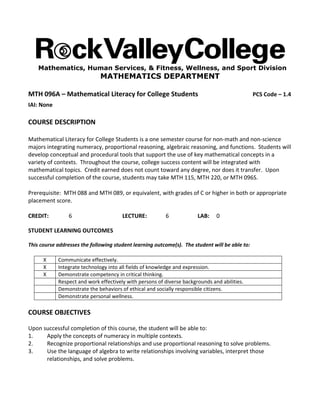
Math Literacy Course Syllabus Rock Valley College
- 1. Mathematics, Human Services, & Fitness, Wellness, and Sport Division MATHEMATICS DEPARTMENT MTH 096A – Mathematical Literacy for College Students PCS Code – 1.4 IAI: None COURSE DESCRIPTION Mathematical Literacy for College Students is a one semester course for non-math and non-science majors integrating numeracy, proportional reasoning, algebraic reasoning, and functions. Students will develop conceptual and procedural tools that support the use of key mathematical concepts in a variety of contexts. Throughout the course, college success content will be integrated with mathematical topics. Credit earned does not count toward any degree, nor does it transfer. Upon successful completion of the course, students may take MTH 115, MTH 220, or MTH 096S. Prerequisite: MTH 088 and MTH 089, or equivalent, with grades of C or higher in both or appropriate placement score. CREDIT: 6 LECTURE: 6 LAB: 0 STUDENT LEARNING OUTCOMES This course addresses the following student learning outcome(s). The student will be able to: X X X Communicate effectively. Integrate technology into all fields of knowledge and expression. Demonstrate competency in critical thinking. Respect and work effectively with persons of diverse backgrounds and abilities. Demonstrate the behaviors of ethical and socially responsible citizens. Demonstrate personal wellness. COURSE OBJECTIVES Upon successful completion of this course, the student will be able to: 1. Apply the concepts of numeracy in multiple contexts. 2. Recognize proportional relationships and use proportional reasoning to solve problems. 3. Use the language of algebra to write relationships involving variables, interpret those relationships, and solve problems.
- 2. 4. 5. Interpret and move flexibly between multiple formats including graphs, tables, equations, and words. Develop the ability to think critically and solve problems in a variety of contexts using the tools of mathematics including technology. COURSE OBJECTIVES DETAILS Upon successful completion of this course, the student will be able to: Numeracy 1. Demonstrate operation sense and the effects of common operations on numbers in words and symbols. 2. Demonstrate competency in the use of magnitude in the contexts of place values, fractions, and numbers written in scientific notation. 3. Use estimation skills. 4. Apply quantitative reasoning to solve problems involving quantities or rates. 5. Demonstrate measurement sense. 6. Demonstrate an understanding of the mathematical properties and uses of different types of mathematical summaries of data. 7. Read, interpret, and make decisions based upon data from line graphs, bar graphs, and charts. Proportional reasoning 8. Recognize proportional relationships from verbal and numeric representations. 9. Compare proportional relationships represented in different ways. 10. Apply quantitative reasoning strategies to solve real-world problems with proportional relationships. Algebraic reasoning 11. Understand various uses of variables to represent quantities or attributes. 12. Describe the effect that changes in variable values have in an algebraic relationship. 13. Construct and solve equations or inequalities to represent relationships involving one or more unknown or variable quantities to solve problems. Functions 14. Translate problems from a variety of contexts into a mathematical representation and vice versa. 15. Describe the behavior of common types of functions using words, algebraic symbols, graphs, and tables. 16. Identify the reasonableness of a linear model for given data and consider alternative models. 17. Identify important characteristics of functions in various representations. 18. Use appropriate terms and units to describe rate of change. 19. Understand that abstract mathematical models used to characterize real-world scenarios or physical relationships are not always exact and may be subject to error from many sources.
- 3. Mathematical success 20. Develop the ability to use mathematical skills in diverse scenarios and contexts. 21. Use technology appropriately including calculators and computers. 22. Demonstrate critical thinking by analyzing ideas, patterns, and principles. 23. Demonstrate flexibility with mathematics through various contexts, modes of technology, and presentations of information (tables, graphs, words, equations). 24. Demonstrate and explain skills needed in studying for and taking tests. COURSE TOPIC OUTLINE I. Numeracy Arithmetic operations of whole numbers, integers, fractions, decimals, and percents Magnitude and scientific notation Estimation - knowing how and when to estimate results, to solve problems and to detect errors Problems involving quantities or rates Measurement Data interpretation and measures of central tendency Line graphs, bar graphs, and charts Measures of central tendency Calculator (hand-held and online) skills II. Proportional Reasoning Proportional relationships from verbal and numeric representations Comparing proportional relationships Applying quantitative reasoning strategies to solve real-world problems involving proportionality Using similarity to solve applications Using dimensional analysis to convert units of measure Writing and solving proportions III. Algebraic Reasoning Uses of variables Effects of variables on other variables in the algebraic relationship Constructing and using equations or inequalities Writing and interpreting compound inequalities in one variable Writing and simplifying algebraic expressions by using the distributive property, combining like terms, and/or factoring the GCF The Pythagorean Theorem
- 4. IV. Functions Translating problems into a mathematical representation and vice versa including linear, exponential, and quadratic functions Behavior of common types of functions using expressions, graphs, and tables Identifying linear models Characteristics of functions including slope, points, intercepts, inputs and outputs Using appropriate terms and units to describe rate of change Understand mathematical models Applying formulas to solve problems related to perimeter, area, and volume Order of operations Solving a formula for one of its variables Interpreting slope as a rate of change Writing and solving systems of linear equations in two variables Determining solutions for linear inequalities Use of Excel METHODS OF STUDENT ASSESSMENT Students will be evaluated using a variety of methods including examinations and written assignments, group work, web based assignments or quizzes. REQUIRED READINGS (AND SUPPLIES) Almy/Foes, Math Lit, Pearson Publishing, latest edition MyMathLab access code Scientific Calculator—TI-30XII recommended RECOMMENDED READINGS (AND SUPPLIES) None DATE PREPARED AND SUBMITTED This syllabus was developed by Kathleen Almy and prepared by the Mathematics Department of the Math, Human Services, and FWS Division, September 13, 2010. REVIEW DATES Updated January 2013